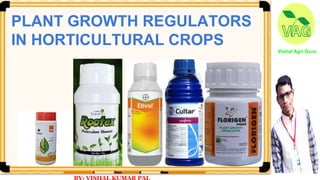Plant growth regulators in horticultural crops
- 1. Vishal Agri Guru PLANT GROWTH REGULATORS IN HORTICULTURAL CROPS
- 2. Vishal Agri Guru PLANT GROWTH REGULATORS IN HORTICULTURAL CROPS 1.Plant Growth Regulators (PGR) known as bio-stimulants or bio-inhibitors modify physiological processes in plant. 2.These organic compounds act inside plant cells to stimulate or inhibit specific enzyme or enzyme systems to regulate plant metabolism. 3.These growth regulators are naturally produced in plants to control the growth and other physiological functions. They act even in very minute quantities.
- 4. Vishal Agri Guru Name of PGR (Hormones) Compound / Trade Name Auxins IAA, IBA, NAA Gibberellins GA1, GA2, GA3,..ŌĆ”GA60 Cytokinins Kinetin, Zeatin Ethylene Ethylene Abscisic Acid (ABA) Phaseic Acid, Dormins Inhibitor Cycocel, MH-40 Common growth regulators
- 6. Vishal Agri Guru ŌĆó Cell Enlargement: It stimulates cell enlargement and stem growth. ŌĆó Cell Division: It stimulates cell division in cambium. Used in tissue culture plant production in combination with Cytokinin. ŌĆó Vascular Tissue Differentiation: It stimulates differentiation of phloem and xylem. ŌĆó Root Initiation: It stimulates root initiation on stem cuttings. Used in plant propagation by tissue culture for development of roots. ŌĆó Apical Dominance: It suppresses the apical shoot growth and promotes the growth of lateral buds. Role of Auxins:
- 7. Vishal Agri Guru ŌĆó Stem growth: Gibberellic Acid (GA) causes hyper elongation of stems by stimulating both cell division and cell elongation. This results in taller plants. ŌĆó Bolting in long day plants: GA cause stem elongation in response to long days. ŌĆó Induction of seed germination: GA activates germination of seeds which otherwise require cold (stratification) or light to induce germination. ŌĆó Enzyme production during germination: GA stimulates the production of enzymes like amylase in germinating cereal grains. Role of Gibberellins:
- 8. Vishal Agri Guru ŌĆó Stomata Closure: Water shortage brings about increase in ABA level, leading to stomata closure as a response to water stress. ŌĆó Growth Inhibitors: ABA inhibits shoot growth but has less effect on root growth. ŌĆó GA Counteracts: ABA counteracts the effect of gibberellins on a- amylase synthesis in germinating cereal grains. ŌĆó Induced Dormancy: ABA affects induction or maintenance of dormancy in seeds. Role of Abscisic Acid (ABA):
- 9. Vishal Agri Guru ŌĆó Fruit Ripening: Ethylene in the form of gas helps ripens fruits under natural conditions. ŌĆó Induction Of Femaleness: Promotes production of female flowers in cucurbits (cucumber, squash, melon) to increase the yield. ŌĆó Flower Opening: Promotes flower initiation and controlled ripening in pineapples. ŌĆó Leaf and Fruit Abscission: Accelerates fruit abscission for mechanical harvesting in fruit crops such as grapes, cherries, and citrus. Role of Ethylene:
- 10. Vishal Agri Guru For more information visit our website: http://vishalagriguruji.blogspot.com/
- 11. Vishal Agri Guru
- 12. Vishal Agri Guru











